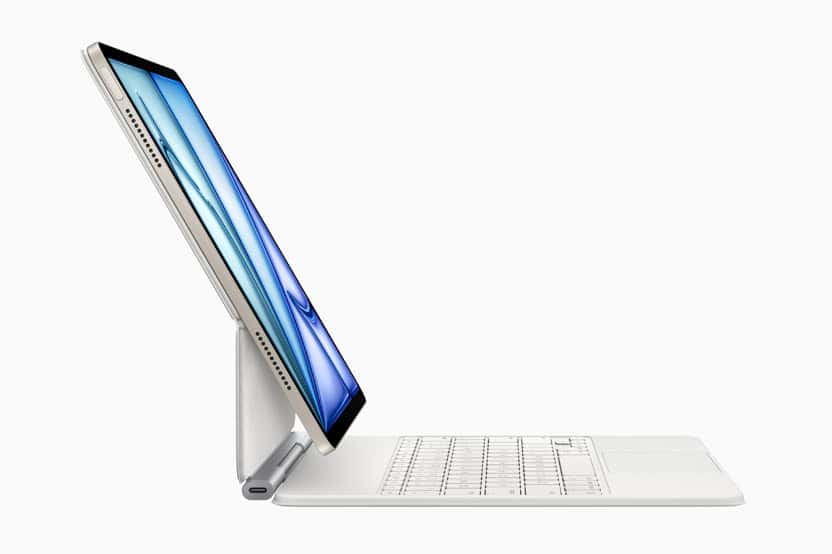Apple is reportedly planning a major performance leap for its iPad Air lineup, with the 2026 model expected to feature the powerful M4 chip. While this next-gen iPad Air will arrive a year after the M3 version slated for spring 2025, the wait could be well worth it. The rumored M4 upgrade signals Apple’s continued push to redefine what a tablet can do—blurring the lines between iPads and Macs more than ever before.
A Strategic Delay — And a Powerful Payoff
The current iPad Air refresh, expected this spring, will introduce the M3 chip to Apple’s mid-tier tablet for the first time. This aligns the Air with the performance tier of the 2023 MacBook Air and 24-inch iMac. But rather than rushing to drop the M4 into the iPad Air lineup immediately after, Apple appears to be taking a more measured approach. Sources suggest the M4-powered iPad Air will be held for 2026, likely to avoid overlapping too closely with the iPad Pro—which received the M4 chip in 2024.
This makes sense within Apple’s broader product strategy. The iPad Air is positioned as the go-to device for power users who don’t need the advanced display tech or LiDAR sensors of the iPad Pro. By giving the M4 chip time to remain a Pro-exclusive for a while longer, Apple maintains clearer product segmentation—at least for now.

Why the M4 Chip Matters
The M4 chip is no minor upgrade. Built on a second-generation 3nm process (N3E), it delivers faster CPU and GPU performance, vastly improved energy efficiency, and a next-gen Neural Engine that’s reportedly capable of up to 38 trillion operations per second. This makes it ideal for AI-powered workflows, on-device machine learning, and high-end creative tasks like 4K video editing or 3D rendering—all on a tablet.
In the 2024 iPad Pro, the M4 enabled real-time voice transcription, image editing, and multitasking experiences that pushed the boundaries of mobile computing. If those capabilities arrive in the iPad Air by 2026, it will bring high-performance features to a broader audience—at a lower price point than the Pro models.
The Evolution of the iPad Air
The iPad Air has steadily evolved from a slimmed-down alternative to the Pro into a powerful machine in its own right. Apple added the M1 chip to the Air in 2022, the M2 in 2023, and the upcoming M3 marks another leap forward. The expected M4 update in 2026 would put it nearly on par with some of Apple’s laptops in raw processing power.
That could change how people use the iPad Air altogether. With the rise of desktop-grade apps for iPadOS—like Final Cut Pro, Logic Pro, and DaVinci Resolve—many users are already substituting iPads for their MacBooks. An M4-powered iPad Air could accelerate that trend by giving creatives and power users a thinner, lighter, yet still incredibly capable alternative.
What To Expect in 2026
While details remain speculative, here’s what we may see in the 2026 iPad Air:
- M4 chip with up to 10-core CPU and improved Neural Engine
- OLED or improved mini-LED display (based on Pro trickle-down)
- Better battery life thanks to enhanced efficiency
- Improved thermal design to handle M4-level power in a slim chassis
- Possibly a 12.9-inch variant, following rumors of a larger Air model
A New Chapter for the Mid-Range iPad
With the iPad Air gaining ground in performance and versatility, it’s becoming the sweet spot in Apple’s tablet lineup—ideal for students, professionals, and creatives who want power without the Pro price tag. If the M4 chip makes its way into the 2026 model, it could mark a significant turning point where the Air truly becomes the “just right” device for most users.
In the meantime, the upcoming M3 iPad Air will set the stage, but the M4 version is already shaping up to be one of the most anticipated iPad releases in years.
Key Takeaways
- The iPad Air with M4 chip will offer major performance upgrades with better graphics and AI features.
- Apple will likely release an M3 iPad Air first this spring before the M4 version arrives in 2026.
- The 2026 iPad Air will maintain its position between entry-level and Pro models with mid-range pricing.
Overview of the Apple iPad Air Evolution
The iPad Air has transformed from a lightweight alternative to the standard iPad into a powerful device that now rivals the iPad Pro in many aspects. Apple’s consistent upgrades to processors, displays, and accessories have positioned the iPad Air as a versatile option for both casual users and professionals.
From the First iPad Air to Present
The original iPad Air launched in 2013, marking Apple’s shift toward thinner, lighter designs. It was 28% lighter and 20% thinner than previous iPads, revolutionizing tablet portability.
The iPad Air 2 followed in 2014 with the A8X chip and Touch ID. After a long gap, Apple revived the line in 2019 with the iPad Air 3, adding Apple Pencil support.
2020 brought a major redesign with the iPad Air 4. This model introduced an all-screen design, USB-C, and moved Touch ID to the power button. It also added support for the Magic Keyboard.
The 2022 iPad Air 5 featured the M1 chip, bringing pro-level performance. In early 2025, Apple released an iPad Air with the M3 chip and improved features.
Comparison with iPad Pro and iPad Mini
The iPad Air sits between the Pro and Mini in Apple’s lineup, balancing performance and affordability.
Key differences:
| Feature | iPad Air | iPad Pro | iPad Mini |
|---|---|---|---|
| Processor | M3 (2025) | M2/M3 | A15 Bionic |
| Display | 10.9″ Liquid Retina | 11″/12.9″ ProMotion | 8.3″ Liquid Retina |
| Price Range | Mid-tier | Premium | Entry-level |
| Target Users | General users, light professionals | Creative pros, power users | Portability-focused users |
The Air lacks the Pro’s ProMotion display and high-end camera system but offers most pro features at a lower price. The Mini provides similar capabilities in a smaller form factor.
Recent rumors suggest Apple may skip directly to the M4 chip for the next iPad Air update, further blurring the line between Air and Pro models.
The Anticipated M4 Chip
Apple’s M4 chip is set to bring significant performance upgrades to the iPad Air lineup. This next-generation silicon will likely offer enhanced processing power alongside better energy efficiency compared to previous models.
Performance Expectations
The M4 chip is rumored to offer increased core counts, enhanced graphics capabilities, and better thermal management. These improvements will directly impact everyday tasks and demanding applications. Users can expect faster app launches and smoother multitasking experiences.
The CPU in the M4 will likely feature more performance and efficiency cores than its predecessors. This boost should result in computing power that handles complex tasks with ease.
Graphics performance will also see major improvements. The GPU in the M4 chip may include additional cores that help with video editing, gaming, and graphic design work.
The Neural Engine will probably get upgrades too. This specialized part handles AI and machine learning tasks, making features like photo enhancements and voice recognition much faster.
Advancements from M2 and M3 Chips
The M4 chip builds on the success of earlier Apple silicon. The M3 chip found in the current iPad Air models will be surpassed in several key areas.
Battery efficiency should improve with the M4. This means longer usage time between charges, which is critical for portable devices.
Unified memory architecture will likely see increases in both capacity and speed. This shared memory system lets the CPU, GPU, and Neural Engine work together without the bottlenecks of traditional systems.
The M4 may also include specialized media engines for video encoding and decoding. These help with processing high-resolution video content while using less power.
Temperature control will likely be better in the M4 compared to M2 and M3 chips. This means the iPad can run demanding apps longer without slowing down due to heat issues.
Design and Display Innovations
The upcoming iPad Air with M4 chip is expected to introduce significant changes to both its physical design and display technology. These innovations aim to enhance user experience while maintaining the balance between performance and portability.
Potential Redesign Features
The 2026 iPad Air may feature a slimmer profile than current models. Apple is likely working on reducing the overall thickness while maintaining structural integrity. The bezels might shrink further, increasing the screen-to-body ratio for a more immersive experience.
The chassis could incorporate more recycled materials, aligning with Apple’s environmental goals. This wouldn’t compromise durability, as new alloys might actually strengthen the frame.
Button placement might be reworked for better ergonomics. Some industry experts suggest the power button with Touch ID might get refinements for faster recognition.
Port selection could see updates too. USB-C will likely remain, but with improved data transfer speeds to match the M4’s capabilities.
OLED and Mini-LED Display Technology
Display technology in the 2026 iPad Air might see a dramatic shift. Apple is expected to leverage advanced display architecture, possibly including OLED or Mini-LED options.
OLED displays would bring perfect blacks and higher contrast ratios to the iPad Air. Colors would appear more vibrant, and the display could be thinner than current LCD panels.
Mini-LED technology, already used in some iPad Pro models, might trickle down to the Air. This would bring:
- Higher peak brightness for HDR content
- Better local dimming for improved contrast
- More energy-efficient operation
Both technologies would likely support higher refresh rates, perhaps 120Hz ProMotion that adapts to content. This would make scrolling smoother and improve the Apple Pencil experience.
Battery life should improve despite these enhancements, as both OLED and Mini-LED are more power-efficient than traditional LCDs.
Enhanced Connectivity and Ports
The upcoming iPad Air with M4 chip will feature significant improvements to its connectivity options and port selection. These enhancements aim to provide users with faster data transfer speeds and more versatile connectivity for professional and personal use.
Upgraded Smart Connector
The 2026 iPad Air will come with an improved Smart Connector that offers faster data transfer rates. This upgrade allows for better performance when using compatible accessories like the new Magic Keyboard. The connector now supports higher power delivery, enabling users to connect more power-hungry accessories.
Apple has redesigned the Smart Connector to be more durable and resistant to wear. This means less connection issues over time even with frequent attachment and detachment of accessories.
The new iPad Air will include:
- Thunderbolt 4 ports for ultra-fast data transfers
- USB-C connectivity with increased power delivery
- Support for external displays with up to 6K resolution
Integration with Apple Ecosystem
The 2026 iPad Air will feature Wi-Fi 6E and 5G connectivity, providing users with the fastest wireless speeds available. This makes the device ideal for streaming high-quality content and cloud-based work.
The iPad Air can function as a Smart Home Hub, allowing users to control their HomeKit devices directly. This integration turns the iPad into a central command center for the modern smart home.
Bluetooth 5.3 technology improves connections with wireless accessories like AirPods and Apple Pencil. The range and stability of these connections are notably better than previous generations.
When paired with Apple TV 4K, the iPad Air acts as an extended screen or controller. Users can start watching content on their iPad and seamlessly transfer it to their TV with a single tap.
Camera and Visual Capabilities
The 2026 iPad Air with M4 chip is expected to bring significant upgrades to its camera system and visual features. These improvements will enhance both photography and augmented reality experiences for users.
Comparison with Competitors
The upcoming iPad Air’s camera system is rumored to include a 12MP front-facing camera with Center Stage technology, which automatically keeps users centered in the frame during video calls. This matches what Apple has already introduced in its 2025 MacBook Air lineup.
Unlike Samsung’s Galaxy Tab S10, which features dual rear cameras, the 2026 iPad Air will likely stick with a single but highly capable rear camera. Apple plans to focus on image quality over multiple lenses.
The M4 chip will enable faster image processing and improved computational photography features. This will help the iPad Air compete against Microsoft’s Surface Pro X, which has emphasized AI-enhanced photo editing.
Video recording capabilities are expected to support 4K at 60fps, with better low-light performance than previous models.
Augmented Reality and AI Features
The M4 chip’s enhanced graphics capabilities will power next-generation AR experiences on the iPad Air. The improved thermal management will allow for longer AR sessions without performance throttling.
Face ID integration might finally come to the iPad Air line, replacing Touch ID and enabling secure facial recognition for AR apps. This would match what’s already available on iPad Pro models.
AI photo enhancement will likely be a major feature, with the M4 chip handling complex tasks like object removal, scene optimization, and style transfers directly on-device without needing cloud processing.
Developers will benefit from new AR creation tools that utilize the M4’s neural engine. These tools will make it easier to build immersive experiences that blend digital content with the real world.
The LiDAR scanner, previously limited to Pro models, might make its debut on the iPad Air, enabling precise depth mapping for AR applications.
Battery and Power Efficiency
The upcoming iPad Air with the M4 chip promises significant improvements in how long you can use your device between charges. The new processor’s design focuses on doing more work while using less power.
Improvements in Battery Life
The M4 chip is expected to greatly extend the iPad Air’s battery life through its advanced 3-nanometer architecture. This smaller, more efficient design allows the processor to complete tasks while using much less energy than previous generations. Users might see up to 20% longer battery life compared to M2-equipped models.
The chip’s improved power management system can better handle background processes. This means your iPad won’t drain battery when you’re not actively using it.
Apple has also worked on optimizing iPadOS to work perfectly with the M4 chip. The software and hardware combination enables the system to reduce power consumption while maintaining performance.
Charging Innovations
The 2026 iPad Air may introduce faster charging capabilities to complement its improved battery life. Reports suggest Apple is testing new charging technologies that could cut recharge times by 30%.
USB-C will remain the standard charging port, but with enhanced power delivery. This means the iPad can charge more quickly when paired with compatible chargers.
Apple is also rumored to be improving wireless charging options. The new iPad Air might support reverse wireless charging, allowing it to charge smaller devices like AirPods.
Battery health management features will be more advanced too. The system will learn your charging habits and adjust power delivery to maximize long-term battery lifespan.
Software and Operating System
The iPad Air’s upcoming software ecosystem will provide both enhanced productivity features and deeper integration with Apple’s growing services portfolio. Apple’s focus on operating system improvements and AI capabilities aims to maximize the M4 chip’s potential.
Upcoming OS Features
iPadOS 20 is expected to ship with the new iPad Air, bringing significant improvements that take advantage of the M4 chip’s processing power. The update will likely include Apple Intelligence features that were first introduced with the M4 iPad Pro in 2024.
Key features may include:
- Enhanced multitasking tools that allow for more desktop-like workflows
- Improved Apple Pencil support with lower latency and more natural writing
- Better external display handling for productivity setups
Security enhancements will also be a priority. Apple is expected to implement improved on-device encryption and advanced biometric authentication options to protect user data without compromising performance.
The M4 chip’s neural engine will enable more complex AI tasks to run directly on the device rather than in the cloud. This keeps private information secure while still delivering powerful features.
Integration with Apple Services
The new iPad Air will likely feature deeper integration with Apple’s expanding ecosystem of services. Users can expect optimized experiences for Apple TV+, Apple Music, and iCloud+.
Apple’s services will benefit from the M4 chip through:
- Faster content downloads and smoother streaming experiences
- Improved offline capabilities for working without internet access
- Better battery efficiency when using subscription services
The iPad Air may also include new Apple Intelligence features that help organize content across services. Smart recommendations could surface relevant documents, photos, and media based on what you’re currently working on.
Apple is rumored to be developing cross-device continuity features that make switching between iPad Air and other Apple devices even more seamless. This would allow for instant handoff of complex workflows, not just basic app states.
Market Positioning and Pricing
The new iPad Air with M4 chip aims to bridge the gap between consumer and professional tablets, with strategic pricing that reflects its enhanced capabilities while maintaining accessibility for various user segments.
Competitive Analysis
The 2026 iPad Air with M4 chip will likely position itself as a mid-tier powerhouse in Apple’s tablet lineup. It will sit above the Low-Cost iPad but below the iPad Pro models in both price and features. This strategic placement targets creative professionals, students, and productivity-focused users who need more power than entry-level tablets but don’t require the full Pro feature set.
Compared to competitors like Samsung’s Galaxy Tab series and Microsoft’s Surface tablets, the M4-powered iPad Air will offer superior processing power. The M4 chip’s advanced 3-nanometer architecture will likely provide better performance per watt than Android and Windows alternatives.
Key advantages will include:
- Better app ecosystem optimized for tablets
- Longer software support (5-7 years)
- Superior battery efficiency
- Tighter integration with Apple devices
Expected Pricing for Different Models
The 2026 iPad Air with M4 chip will likely follow Apple’s established pricing tiers with slight adjustments to reflect the upgraded technology. Based on previous patterns, here’s what consumers might expect:
Base Model (64GB): $599-$649
Mid-Tier Model (256GB): $749-$799
Top-Tier Model (512GB): $949-$999
Wi-Fi + Cellular options will add approximately $150 to each configuration. Apple may also introduce a new 1TB option for content creators, priced around $1,149.
Colors will likely include standard options (Space Gray, Silver) plus 2-3 vibrant choices like the sky blue seen in recent MacBook releases. Education discounts will continue, offering $50-$70 off retail prices to make the device more accessible to students.
Launch and Purchase Details
The iPad Air with M4 chip will follow Apple’s established release patterns with strategic timing and enhanced security measures for customer purchases. Apple has refined its launch process to ensure a smooth transition from announcement to availability.
Announcement Date and Pre-Order Information
Apple plans to announce the M4 iPad Air in early 2026, with a formal unveiling expected during a spring event. Pre-orders will likely begin immediately following the announcement, similar to previous iPad launches where customers could reserve their devices before retail availability.
The official market release is anticipated to occur roughly 10 days after the announcement. If Apple follows their established pattern, pre-orders might begin on a Friday, with shipments starting the following Friday.
Pricing is expected to remain consistent with previous generations, starting at $599 for the base configuration. Higher storage options and cellular connectivity will come at premium pricing tiers.
Authorized retailers will accept pre-orders alongside Apple’s website and stores. Early pre-order customers typically receive priority shipping.
Security and Purchase Verification
Apple will implement robust security measures for the M4 iPad Air purchase process. Two-factor authentication will be required for all Apple ID accounts making purchases through the Apple Store.
Customers must verify their identity during checkout using:
- Apple ID password
- Biometric authentication (Face ID or Touch ID)
- SMS verification code for new payment methods
Purchase limits of two devices per customer will likely be enforced during the initial launch period to prevent reseller exploitation. This helps ensure genuine customers can access the new technology.
For in-store pickup, customers will need to show photo identification matching the name on the order. Apple has strengthened these verification steps to combat fraud and unauthorized purchases.
International orders will require additional verification steps to comply with regional security requirements and import regulations.
Potential Impact on Apple’s Product Lineup
The expected M4 chip in the iPad Air will likely shift how Apple positions its devices across its lineup, affecting both pricing and feature differentiation between models. This change could create new dynamics between Apple’s portable devices.
Comparison with MacBook Air and MacBook Pro
The iPad Air with M4 will blur lines between tablets and laptops even further. Recent M4 MacBook Air releases show Apple’s commitment to bringing cutting-edge chips across product categories.
Performance gaps will narrow, with the iPad Air potentially matching entry-level MacBooks in raw power. This raises questions about device choice for consumers who previously selected MacBooks solely for performance.
Pricing strategy becomes crucial. If the M4 iPad Air costs significantly less than MacBook Air models, some users might choose the tablet with a keyboard attachment instead of a laptop.
The main differences will likely focus on operating systems rather than hardware limitations. iPadOS will continue to evolve, but macOS still offers more professional workflow options.
Synergy with Other Apple Devices
The M4 iPad Air will strengthen Apple’s ecosystem integration. Users with iPhone 16 or iPhone 17 devices will benefit from improved continuity features and faster data syncing between devices.
Mac Studio and Mac Pro users might find the M4 iPad Air a perfect portable complement to their high-powered desktops. The chip enables seamless workflows between devices, letting users start tasks on one device and finish on another.
Battery efficiency will improve with the M4, making the iPad Air a more practical all-day companion device. This positions it as a better secondary screen for Mac owners.
The M4 will also prepare the iPad Air for future AR/VR applications, creating new interaction possibilities with other Apple hardware. This chip may enable features currently impossible on older iPad models.
Future of Apple’s Chip Development
Apple continues to push the boundaries of performance and efficiency with its custom silicon. The M-series chips have transformed Mac and iPad lineups since their introduction, with each generation bringing significant improvements.
M4 Max and M4 Pro Prospects
The M4 chip is already making waves in Apple’s latest devices. According to recent reports, Apple has been working on more powerful versions of this chip. The Mac Pro is expected to receive high-end M4 chips later in 2025, alongside the Mac Studio.
These professional-grade chips will likely feature:
- More CPU and GPU cores
- Enhanced neural engine capabilities
- Improved memory bandwidth
- Better power efficiency
The M4 Pro and M4 Max variants will probably follow Apple’s established pattern of scaling up performance for professional users. These chips may double or triple the base M4’s processing power while maintaining reasonable power consumption.
Long-Term Vision for Apple Silicon
Apple Silicon represents more than just a move away from Intel. It’s a strategic shift that gives Apple complete control over its hardware and software integration.
Future chips might include:
- Specialized AI processing units
- Advanced graphics capabilities for AR/VR applications
- Custom components for specific professional tasks
The current M3 to M4 transition shows Apple’s commitment to regular performance upgrades. We can expect this pattern to continue with yearly improvements.
Apple’s chip roadmap likely extends several years ahead, with each generation building on previous successes. The company’s ability to design chips specifically for its own devices gives it a unique advantage in optimizing performance and battery life.
Frequently Asked Questions
Apple fans want answers about the upcoming iPad Air with the M4 chip. These questions cover specs, release timing, and performance improvements expected in the next model.
What are the predicted specifications for the upcoming iPad Air model?
The next iPad Air is expected to feature Apple’s powerful M4 chip. This represents a major step up from current models.
The device may come with improved display technology and a redesigned Magic Keyboard accessory. Storage options will likely start at 128GB with options up to 1TB.
Battery improvements are also expected, with better power efficiency thanks to the M4 chip architecture.
When is the expected release date for the next-generation iPad Air?
Most industry reports point to a 2026 release window for the M4 iPad Air. This timeline aligns with Apple’s typical upgrade cycle for the iPad Air line.
Some earlier reports suggested a 2025 release, but more recent information from industry analysts suggests the timeline has shifted to 2026. Apple suppliers are already preparing components for new iPads.
What is the anticipated lifespan of the new iPad Air in terms of software updates?
The M4-equipped iPad Air will likely receive software updates for 5-7 years after release. This estimate is based on Apple’s support history for previous iPad models.
With the more powerful M4 chip, this iPad Air may even see extended support compared to earlier models. Apple typically provides longer software support for devices with newer chip architecture.
The tablet should support at least through iPadOS 21 and beyond, keeping it current well into the 2030s.
Are there any rumors about Apple discontinuing the iPad Air line in the future?
There are no credible rumors suggesting Apple plans to discontinue the iPad Air line. In fact, the upcoming M4 update indicates continued investment in the product category.
The iPad Air serves as the middle option between the base iPad and iPad Pro, filling an important price and performance gap. Apple’s continued updates to the Air line suggest it remains a strategic product.
Recent sales data shows the iPad Air remains popular with consumers who want pro-level features without pro-level pricing.
What are the differences between the iPad Air 4th generation and the upcoming model?
The current iPad Air features an M3 chip, while the upcoming model will use the more powerful M4 processor. This represents a significant performance jump.
The new model may feature an improved display with better brightness and color accuracy. Battery life improvements are also expected, along with potential camera upgrades.
The upcoming iPad Air will likely support more advanced accessories, including a new version of the Magic Keyboard with improved functionality.
Will the new iPad Air model offer significant performance improvements over the previous versions?
Yes, the M4 chip will provide substantial performance gains over previous iPad Air models. Early tests with the M4 chip show it handles demanding tasks like gaming with ease.
Users can expect faster app loading times, smoother multitasking, and better performance with creative apps like video editing software. The chip is designed to be more energy-efficient while delivering more computing power.
Graphics performance should also see notable improvements, making the new iPad Air better for games and graphic-intensive applications.







